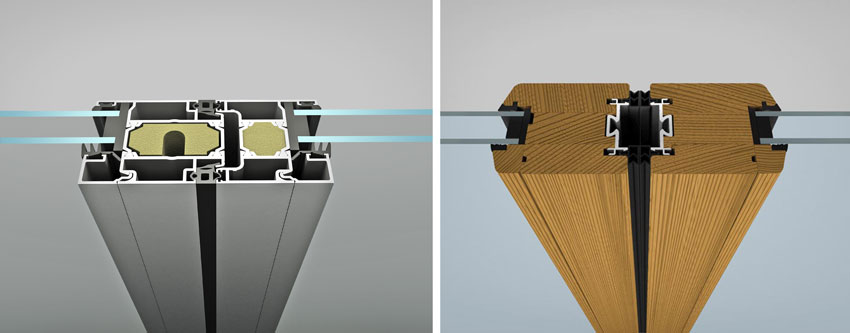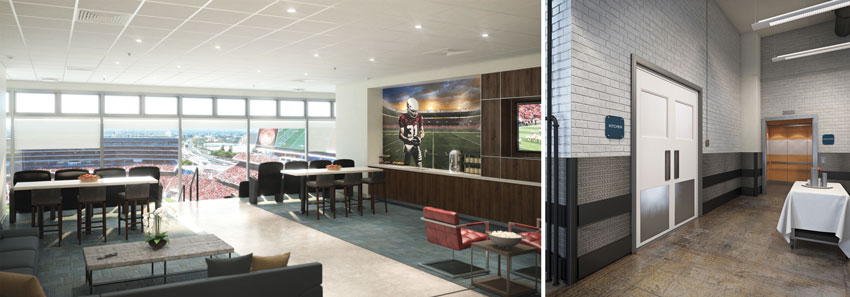System Solutions for Stadiums
Stadium Performance Considerations
While the design considerations of different aspects of stadiums and arenas drive many decisions, so do the performance and durability aspects of many of the products and materials used. In that regard, let’s turn our attention to some of the ways to optimize the overall performance of the systems being considered.
Operable Glass Wall Performance
Manufacturers offer operable glass walls that are panelized systems framed in wood or aluminum and can even provide frameless all-glass systems. All of these products are designed and tested to meet multiple design requirements for stadiums either for exterior-facing or interior-only applications. Operable glass walls can be full wall height, match standard door heights, or be used in shorter heights for continuous window style applications as well. The openings can range in width from as little as 9 feet wide up to as much as 300 feet or more. They are typically comprised of uniformly sized panels with a top and bottom track along which the doors either fold or slide. The wood- or aluminum-framed systems provide a traditional look that relies on the frame design to achieve superior performance. Frameless opening glass walls offer an all-glass, low-profile panel for maximum view while still meeting testing criteria for weather resistance. Like any other type of building fenestration, these systems do not carry any structural load from the building but rely on being appropriately attached to the building to operate within a structurally supported opening.
This is all good news for architects who have different design criteria and needs for creating spaces that can be enclosed or open at will but need the assurance that they will perform as intended, particularly when closed. That performance takes several forms, especially when they separate conditioned and unconditioned spaces and need to address a variety of environmental conditions. With the panels open during pleasant weather, they can allow fresh air and connection to the outdoor event area. When the panels are closed, however, they need to create a secure, weather-resistant barrier that protects against rain, snow, humidity, noise, and extreme temperatures. Because of the typically large opening sizes, the corresponding large perimeter area, and multiple joints between panel sections, the ability to seal tightly along all of these locations when closed is important. From an operational standpoint, the glass panels need to easily glide or fold into position, meaning that the mounting and tracking mechanisms must be proven and reliable.
The manufacture and production of operable glass wall systems can certainly vary between suppliers since they require considerable diligence and attention to detail in order achieve high-performance levels. Hence, it is incumbent on specifiers to request independent testing reports on the selected products to determine the results for thermal performance, penetration of wind or water, security, and acoustical characteristics. This stringent and thorough third-party testing ensures optimum performance for specific site conditions. It also means that interior separation of spaces between several smaller groups is effective and does not compromise those users either.

Images courtesy of NanaWall Systems
Operable glass walls are available in aluminum and wood, which can all be specified to meet performance requirements in stadiums and arenas.
Designing for Back-of-House Areas
While the public areas of a stadium or arena are what typically come to mind for the experience of spectators or attendees, there are many other areas that require design attention too. These include the “back-of-house” areas, such as kitchens, service corridors, employee lounges, administrative offices, loading docks, storage, media booths, and similar spaces not typically open to the public. In the interest of smooth facility operations, long-term durability, and ease of maintenance, architects need to work with facility managers and other appropriate personnel to be sure that the needs of these important user groups are met too.

Photos courtesy of Inpro
Protecting walls, doors, and other surfaces from damage by people or equipment is particularly important in the back-of-house areas of a stadium, but decorative elements like custom-printed wall protection are fitting for public areas as well.
The back-of-house areas are typically where the actual work of the stadium is conducted—indeed some have referred to it as the “nerve center” for a facility. This is where staff operates, where food and goods are transported on carts, and where furniture or stages and playing fields are moved, assembled, disassembled, and stored. In the case of stadiums, it can also include some of the pedestrian circulation areas, such as stairways and hallways, that connect spaces. Depending on the size of the stadium, the event schedule, or the time of day, these back-of-house spaces can generate a great deal of activity, some of which may not be kind or forgiving to the building walls, floors, doors, or other surfaces. Recognizing these demands, building designers must not only consider aesthetics and design appearance when selecting finish materials and products in these areas, but they must also consider durability and long-term cost effectiveness. Given the high volume of people and the movement of carts or other equipment, these areas have the potential for a lot of interior damage. Sometimes improperly executed “value engineering” is undertaken to reduce first costs, but that can take a toll within the first year of opening. Upfront “cost savings” that are achieved through the selection of “cheaper” materials or the outright elimination of key products eventually show up later on through predictable damage or vandalism. Then the property’s general manager or chief engineer has no choice but to find money in the operating budget to install new products to replace broken/torn ones or to fix damage—all of which would likely have been less expensive to address in the first place during the construction or renovation of the facility.
What type of products are we talking about? Typically, the kinds of things that are noted in Division 10 of architectural specifications, such as corner guards, wall protection materials, wall base, door bumpers, or even interior bollards. All of these are provided to lessen the potential damage to the facility, especially in places like club level suites and back-of-house areas. Typically, back-of-house protection products need to provide a higher level of impact resistance than products used in the front of house. The use of materials like diamond plate steel, HDPE lumber, heavy gauge stainless, and rubber, often in combination, are usually needed in order to stand up to all the wheeled and vehicle traffic running in service corridors. If those corridors contain expansion joints, then heavy-duty covers will be needed to protect them from damage too.
It is worth noting that service corridors often include customer restrooms and may act as a passageway from back-of-house areas. It’s these transition zones that can be overlooked in design and planning and end up looking war-torn and battered within months of the grand opening. In this case, a bit of protective forethought will keep this area looking new and undamaged. However, adding protection doesn’t mean that design needs to suffer. Woodgrain rigid vinyl sheet, stainless steel, and 3-D trim boards have been used extensively in protecting all types of spaces, including elevator cabs. Similar durable products are available that even incorporate wall art. There are also solid surface materials that can provide a clean, durable, high-end look emulating marble or granite but at a fraction of the cost.
There may also be places to consider using durable fabrics, such as for drapes, nets, roller and vertical blinds, awnings, room dividers, upholstery fabrics, and wall coverings. Usually the first consideration for fabrics is fire code ratings for flame-retardant properties, which most commercial fabrics can meet. Beyond that basic requirement is the ability of the fabric to hold up over time in terms of the integrity of the fabric itself, its color-fast properties, and ability to withstand repeated cleanings. Of course, these fabrics are part of the indoor environment and may come in contact with people more so than other building products so their safety in terms of health effects on people needs to be documented.
Notice

www.americanspecialties.com


www.nanawall.com









